heating MITSUBISHI OUTLANDER 2018 Owner's Manual (in English)
[x] Cancel search | Manufacturer: MITSUBISHI, Model Year: 2018, Model line: OUTLANDER, Model: MITSUBISHI OUTLANDER 2018Pages: 441, PDF Size: 13.71 MB
Page 19 of 441
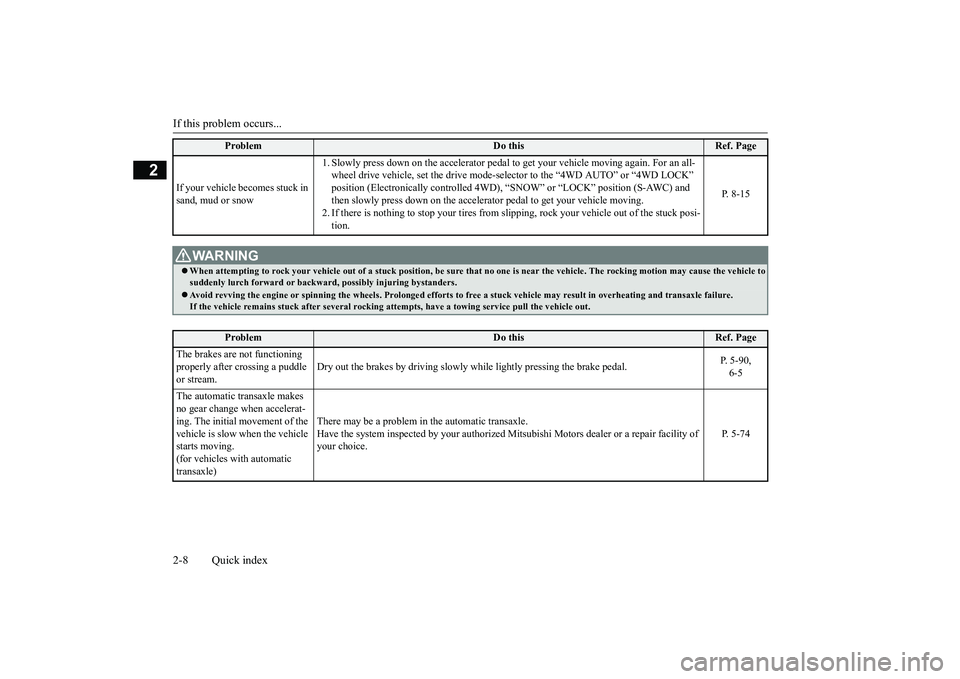
If this problem occurs...2-8 Quick index
2
If your vehicle becomes stuck in sand, mud or snow
1. Slowly press down on the accelerator pedal to
get your vehicle moving again. For an all-
wheel drive vehicle, set the drive mode-sel
ector to the “4WD AUTO” or “4WD LOCK”
position (Electronically cont
rolled 4WD), “SNOW” or “L
then slowly press down on the accelera
tor pedal to get your vehicle moving.
2. If there is nothing to stop your tires from sli
pping, rock your vehicle out of the stuck posi-
tion.
P. 8-15
WA R N I N GWhen attempting to rock your vehi
cle out of a stuck position, be su
re that no one is near the ve
hicle. The rocking motion may c
ause the vehicle to
suddenly lurch forward or backward, possibly injuring bystanders.Avoid revving the engine or spinning the wh
eels. Prolonged efforts to free a stuck ve
hicle may result in
overheating and transa
xle failure.
If the vehicle remains stuck after
several rocking attempts
, have a towing service pull the vehicle out.
Problem
Do this
Ref. Page
The brakes are not functioning properly after crossing a puddle or stream.
Dry out the brakes by driving slowly
while lightly pressing the brake pedal.
P. 5-90,6-5
The automatic transaxle makes no gear change when accelerat-ing. The initial movement of the vehicle is slow when the vehicle starts moving.(for vehicles with automatic transaxle)
There may be a problem in the automatic transaxle.Have the system inspected by your
authorized Mitsubishi Motors de
aler or a repair facility of
your choice.
P. 5-74
Problem
Do this
Ref. Page
BK0249100US.book 8 ページ 2017年5月10日 水曜日 午前8時49分
Page 37 of 441
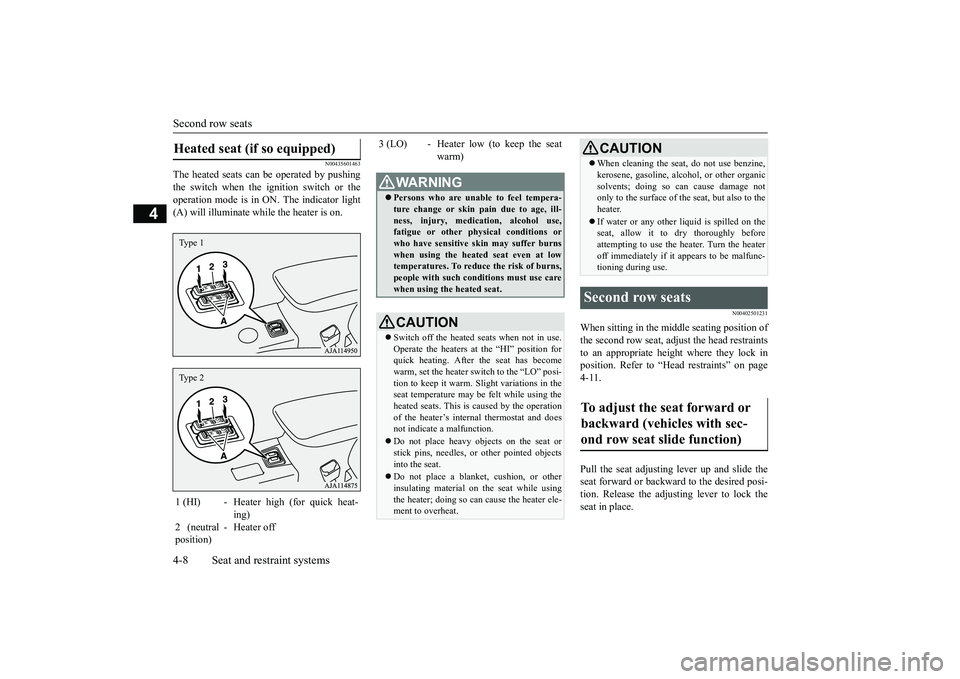
Second row seats4-8 Seat and restraint systems
4
N00435601463
The heated seats can
be operated by pushing
the switch when the ignition switch or theoperation mode is in ON. The indicator light(A) will illuminate while the heater is on.
N00402501231
When sitting in the mi
ddle seating position of
the second row seat, adjust the head restraintsto an appropriate height where they lock inposition. Refer to “Hea
d restraints” on page
4-11. Pull the seat adjusting lever up and slide theseat forward or backward to the desired posi-tion. Release the adjusting lever to lock theseat in place.
Heated seat (if so equipped) 1 (HI) - Heater high (for quick heat-
ing)
2 (neutralposition)
- Heater off
Type 1Type 2
3 (LO) - Heater low (to keep the seat
warm)
WA R N I N GPersons who are unable to feel tempera-ture change or skin
pain due to age, ill-
ness, injury, medication, alcohol use,fatigue or other phys
ical conditions or
who have sensitive sk
in may suffer burns
when using the heated seat even at lowtemperatures. To reduce the risk of burns,people with such conditions must use carewhen using the heated seat.CAUTIONSwitch off the heated seats when not in use.Operate the heaters at the “HI” position forquick heating. After the seat has becomewarm, set the heater switch to the “LO” posi-tion to keep it warm. Sl
ight variations in the
seat temperature may be felt while using theheated seats. This is caused by the operationof the heater’s internal thermostat and doesnot indicate a malfunction.Do not place heavy obj
ects on the seat or
stick pins, needles, or
other pointed objects
into the seat.Do not place a blanket,
cushion, or other
insulating material on the seat while usingthe heater; doing so can
cause the heater ele-
ment to overheat.
When cleaning the seat, do not use benzine,kerosene, gasoline, alc
ohol, or other organic
solvents; doing so can cause damage notonly to the surface of the seat, but also to theheater.If water or any other li
quid is spilled on the
seat, allow it to dry thoroughly beforeattempting to use the heater. Turn the heateroff immediately if it
appears to be malfunc-
tioning during use.
Second row seats To adjust the seat forward or backward (vehicles with sec-ond row seat slide function)
CAUTION
BK0249100US.book 8 ページ 2017年5月10日 水曜日 午前8時49分
Page 136 of 441
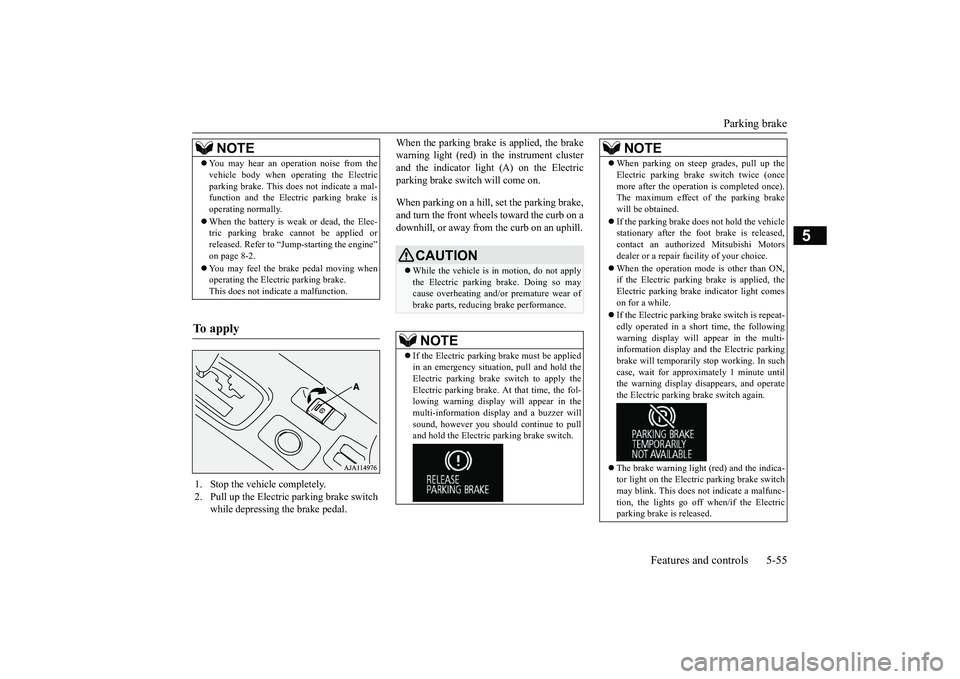
Parking brake
Features and controls 5-55
5
When the parking brake is applied, the brakewarning light (red) in
the instrument cluster
and the indicator light (A) on the Electricparking brake switch will come on.When parking on a hill, set the parking brake,and turn the front wheels toward the curb on adownhill, or away from
the curb on an uphill.
NOTE
You may hear an operation noise from thevehicle body when operating the Electricparking brake. This do
es not indicate a mal-
function and the Elec
tric parking brake is
operating normally.When the battery is weak or dead, the Elec-tric parking brake cannot be applied orreleased. Refer to “Jum
p-starting the engine”
on page 8-2.You may feel the brake pedal moving whenoperating the Electr
ic parking brake.
This does not indi
cate a malfunction.
To apply
1. Stop the vehicle completely.2. Pull up the Electric parking brake switch
while depressing the brake pedal.
CAUTIONWhile the vehicle is in motion, do not applythe Electric parking
brake. Doing so may
cause overheating and/or
premature wear of
brake parts, reducing brake performance. NOTE
If the Electric parking
brake must be applied
in an emergency situa
tion, pull and hold the
Electric parking brake
switch to apply the
Electric parking brake. At that time, the fol-lowing warning display
will appear in the
multi-information disp
lay and a buzzer will
sound, however you should continue to pulland hold the Electric
parking brake switch.
When parking on stee
p grades, pull up the
Electric parking brak
e switch twice (once
more after the operati
on is completed once).
The maximum effect of the parking brakewill be obtained.If the parking brake does not hold the vehiclestationary after the f
oot brake is released,
contact an authorized Mitsubishi Motorsdealer or a repair fa
cility of your choice.
When the operation mode is other than ON,if the Electric parking brake is applied, theElectric parking brake
indicator light comes
on for a while.If the Electric parking brake switch is repeat-edly operated in a short time, the followingwarning display will appear in the multi-information display and the Electric parkingbrake will temporarily stop working. In suchcase, wait for approxima
tely 1 minute until
the warning display di
sappears, and operate
the Electric parking
brake switch again.
The brake warning light (red) and the indica-tor light on the Electric
parking brake switch
may blink. This does no
t indicate a malfunc-
tion, the lights go off when/if the Electricparking brake is released.NOTE
BK0249100US.book 55 ページ 2017年5月10日 水曜日 午前8時49分
Page 151 of 441
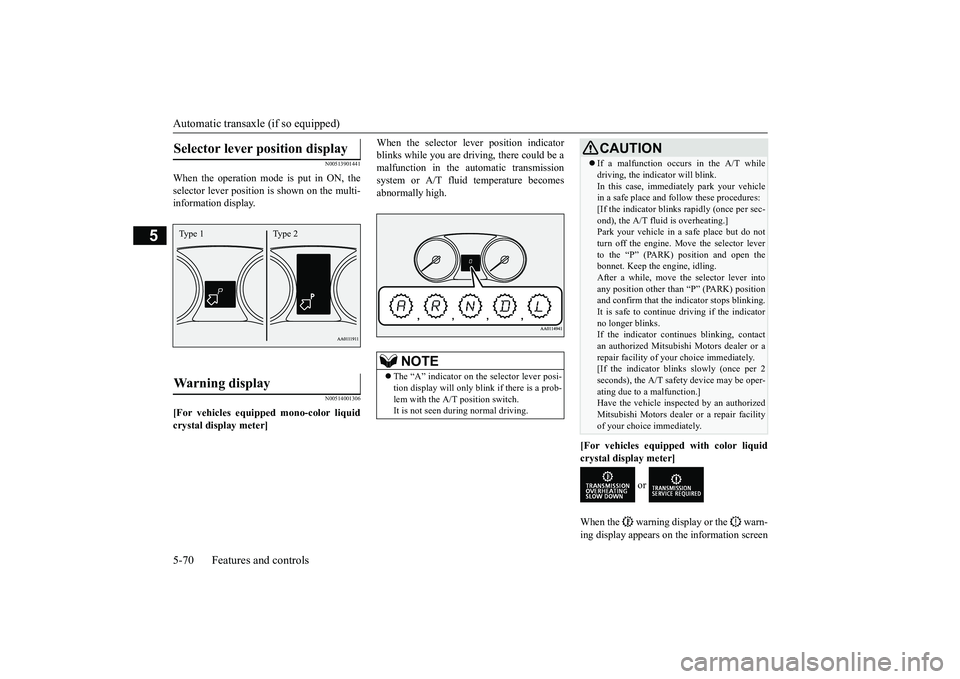
Automatic transaxle (if so equipped)5-70 Features and controls
5
N00513901441
When the operation mode is put in ON, theselector lever position
is shown on the multi-
information display.
N00514001306
[For vehicles equipped mono-color liquidcrystal display meter]
When the selector le
ver position indicator
blinks while you are driv
ing, there could be a
malfunction in the automatic transmissionsystem or A/T fluid temperature becomesabnormally high.
[For vehicles equipped with color liquidcrystal display meter]
or
When the warning display or the warn-ing display appears on the information screen
Selector lever position display
Warning display
Type 1 Type 2
NOTE
The “A” indicator on the selector lever posi-tion display will only blink if there is a prob-lem with the A/T position switch.It is not seen during normal driving.
CAUTIONIf a malfunction occurs in the A/T whiledriving, the indicator will blink.In this case, immediat
ely park your vehicle
in a safe place and fo
llow these procedures:
[If the indicator blinks
rapidly (once per sec-
ond), the A/T fluid is overheating.]Park your vehicle in a safe place but do notturn off the engine. M
ove the selector lever
to the “P” (PARK) position and open thebonnet. Keep the engine, idling.After a while, move the selector lever intoany position other than “P” (PARK) positionand confirm that the i
ndicator stops blinking.
It is safe to continue driving if the indicatorno longer blinks.If the indicator contin
ues blinking, contact
an authorized Mitsubish
i Motors dealer or a
repair facility of your
choice i
mmediately.
[If the indicator blinks slowly (once per 2seconds), the A/T safety
device may be oper-
ating due to a malfunction.]Have the vehicle inspected by an authorizedMitsubishi Motors dealer
or a repair facility
of your choice immediately.
BK0249100US.book 70 ページ 2017年5月10日 水曜日 午前8時49分
Page 152 of 441
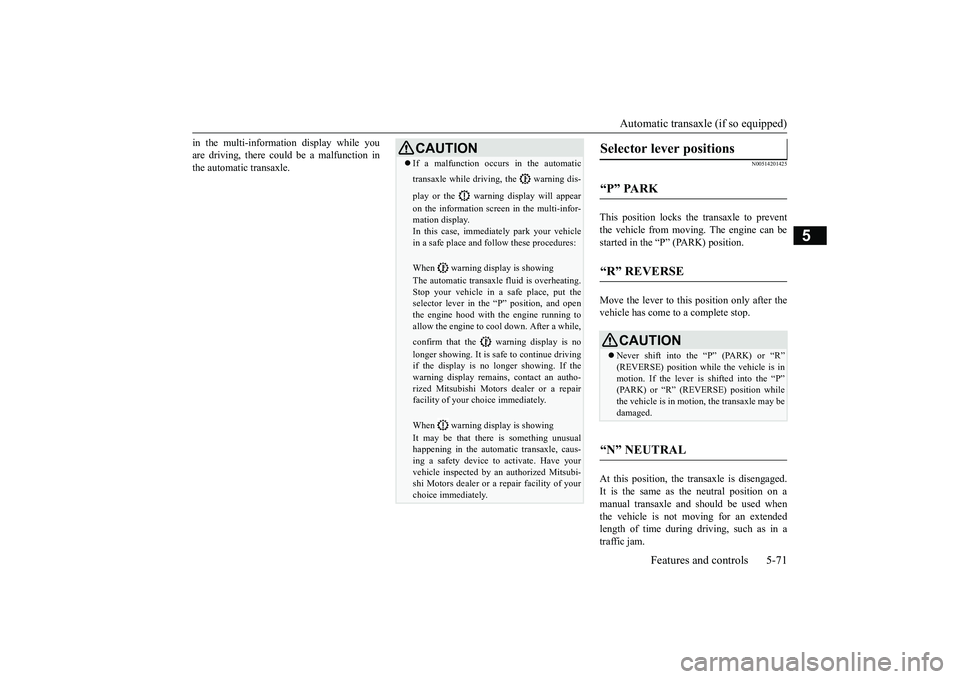
Automatic transaxle (if so equipped)
Features and controls 5-71
5
in the multi-information display while youare driving, there could be a malfunction inthe automatic transaxle.
N00514201425
This position locks the transaxle to preventthe vehicle from moving.
The engine can be
started in the “P” (PARK) position.Move the lever to this position only after thevehicle has come to a complete stop.At this position, the
transaxle is disengaged.
It is the same as th
e neutral position on a
manual transaxle and should be used whenthe vehicle is not moving for an extendedlength of time during driving, such as in atraffic jam.
CAUTIONIf a malfunction occurs in the automatictransaxle while driving, the warning dis-play or the warni
ng display will appear
on the information screen in the multi-infor-mation display. In this case, immediat
ely park your vehicle
in a safe place and fo
llow these procedures:
When warning display is showingThe automatic transaxle fluid is overheating.Stop your vehicle in a
safe place, put the
selector lever in the
“P” position, and open
the engine hood with the engine running toallow the engine to c
ool down. After a while,
confirm that the warning display is nolonger showing. It is safe to continue drivingif the display is no longer showing. If thewarning display remain
s, contact an autho-
rized Mitsubishi Motors
dealer or a repair
facility of your c
hoice immediately.
When warning display is showingIt may be that there is something unusualhappening in the automa
tic transaxle, caus-
ing a safety device to
activate. Have your
vehicle inspected by an
authorized Mitsubi-
shi Motors dealer or a
repair facility of your
choice immediately.
Selector lever positions
“P” PARK
“R” REVERSE
CAUTIONNever shift into the “P” (PARK) or “R”motion. If the lever is shifted into the “P”the vehicle is in moti
on, the transaxle may be
damaged.
“N” NEUTRAL
BK0249100US.book 71 ページ 2017年5月10日 水曜日 午前8時49分
Page 159 of 441
![MITSUBISHI OUTLANDER 2018 Owners Manual (in English) Continuously variable transmission (CVT) (if so equipped)5-78 Features and controls
5
N00560501092
[For vehicles equipped mono-color liquidcrystal display meter]When the selector le
ver position indic MITSUBISHI OUTLANDER 2018 Owners Manual (in English) Continuously variable transmission (CVT) (if so equipped)5-78 Features and controls
5
N00560501092
[For vehicles equipped mono-color liquidcrystal display meter]When the selector le
ver position indic](/img/19/34858/w960_34858-158.png)
Continuously variable transmission (CVT) (if so equipped)5-78 Features and controls
5
N00560501092
[For vehicles equipped mono-color liquidcrystal display meter]When the selector le
ver position indicator
blinks while you are driving, there could be amalfunction in the automatic transmissionsystem or CVT fluid temperature becomesabnormally high.
[For vehicles equipped with color liquidcrystal display meter]
or
When the warning display or the warn-ing display appears on
the information screen
in the multi-information display while youare driving, there could be a malfunction inthe CVT.
NOTE
While the selector le
ver position display is
blinking, a buzzer will
sound intermittently.
Warning display
NOTE
The “A” indicator on th
e selector lever posi-
tion display will only blink if there is a prob-lem with the CVT position switch.It is not seen during normal driving.
CAUTIONIf a malfunction occurs in the CVT whiledriving, the indicator will blink.In this case, immediat
ely park your vehicle
in a safe place and follow these procedures:[If the indicator blinks
rapidly (once per sec-
ond), the CVT fluid is overheating.]Park your vehicle in
a safe place but do not
turn off the engine. M
ove the selector lever
to the
Page 166 of 441
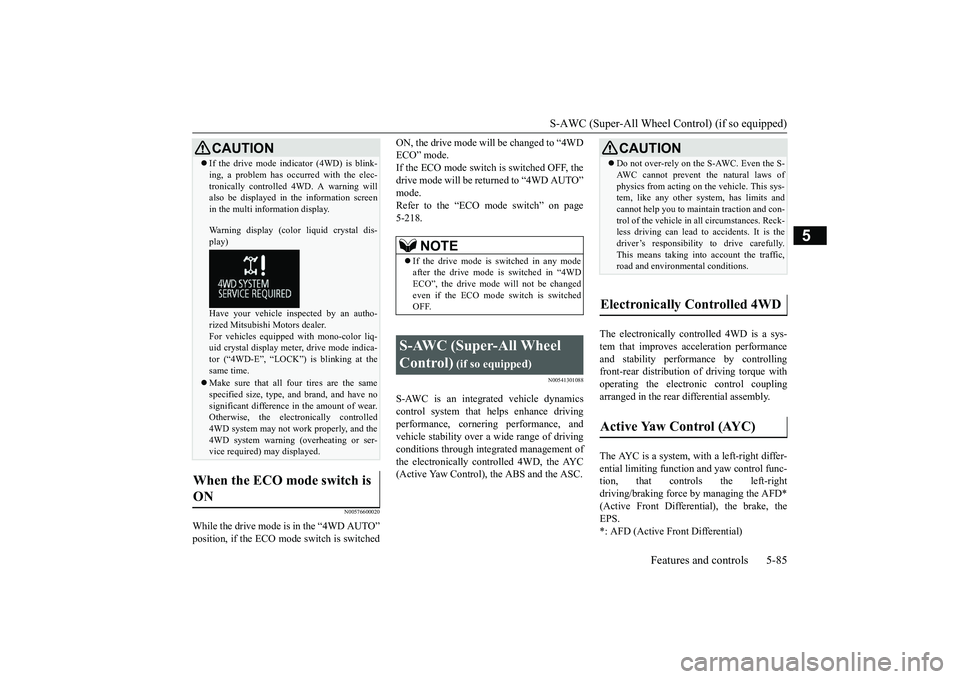
S-AWC (Super-All Wheel Co
ntrol) (if so equipped)
Features and controls 5-85
5
N00576600020
While the drive mode is in the “4WD AUTO”
ON, the drive mode will be changed to “4WDECO” mode.If the ECO mode switch is switched OFF, thedrive mode will be returned to “4WD AUTO”Refer to the “ECO mode switch” on page5-218.
N00541301088
S-AWC is an integr
ated vehicle dynamics
control system that helps enhance drivingperformance, cornering performance, andvehicle stability over a wide range of drivingconditions through integr
ated management of
the electronically cont
rolled 4WD, the AYC
(Active Yaw Control), the ABS and the ASC.
The electronically controlled 4WD is a sys-tem that improves acceleration performanceand stability performance by controllingfront-rear distribution of driving torque withoperating the electronic control couplingarranged in the rear differential assembly.The AYC is a system, with a left-right differ-ential limiting function
and yaw control func-
tion, that controls the left-rightdriving/braking force by managing the AFD*(Active Front Differential), the brake, theEPS.*: AFD (Active Front Differential)
If the drive mode indicator (4WD) is blink-ing, a problem has occurred with the elec-tronically controlled
4WD. A warning will
also be displayed in
the information screen
in the multi information display.Warning display (color
liquid crystal dis-
play)Have your vehicle in
spected by an autho-
rized Mitsubishi Motors dealer.For vehicles equipped with mono-color liq-uid crystal display mete
r, drive mode indica-
tor (“4WD-E”, “LOCK”)
is blinking at the
same time.Make sure that all four tires are the samespecified size, type, a
nd brand, and have no
significant difference
in the amount of wear.
Otherwise, the elec
tronically controlled
4WD system may not work properly, and the4WD system warning (overheating or ser-vice required) may displayed.
When the ECO mode switch is ON
CAUTION
NOTE
If the drive mode is switched in any modeafter the drive mode is switched in “4WDECO”, the drive mode
will not be changed
even if the ECO mode switch is switchedOFF.
S-AWC (Super-All Wheel Control)
(if so equipped)
Do not over-rely on the S-AWC. Even the S-AWC cannot prevent the natural laws ofphysics from acting on the vehicle. This sys-tem, like any other system, has limits andcannot help you to main
tain traction and con-
trol of the vehicle in
all circumstances. Reck-
less driving can lead to
accidents. It is the
driver’s responsibility to drive carefully.This means taking into account the traffic,road and environmental conditions.
Electronically Controlled 4WD
Active Yaw Control (AYC)
BK0249100US.book 85 ページ 2017年5月10日 水曜日 午前8時49分
Page 168 of 441
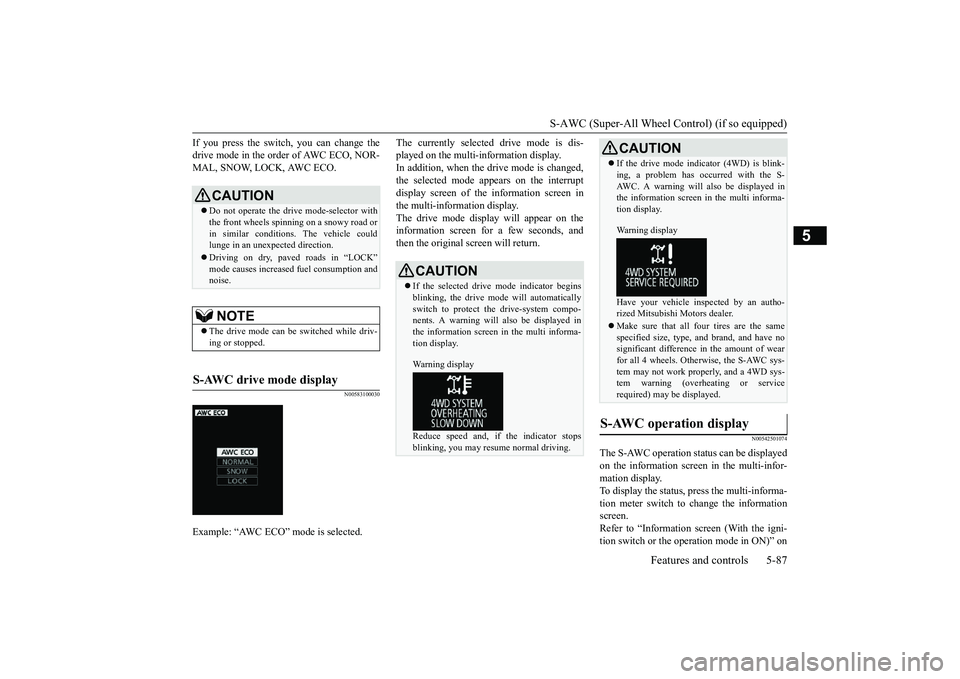
S-AWC (Super-All Wheel Co
ntrol) (if so equipped)
Features and controls 5-87
5
If you press the switch, you can change thedrive mode in the order of AWC ECO, NOR-MAL, SNOW, LOCK, AWC ECO.
N00583100030
The currently selected drive mode is dis-played on the multi-information display.In addition, when the drive mode is changed,the selected mode appears on the interruptdisplay screen of the information screen inthe multi-information display.The drive mode display
will appear on the
information screen for a few seconds, andthen the original screen will return.
N00542501074
The S-AWC operation stat
us can be displayed
on the information screen in the multi-infor-mation display.To display the status, press the multi-informa-tion meter switch to change the informationscreen.Refer to “Information screen (With the igni-tion switch or the operation mode in ON)” on
CAUTIONDo not operate the drive mode-selector withthe front wheels spinning on a snowy road orin similar conditions
. The vehicle could
lunge in an unexpe
cted direction.
Driving on dry, paved roads in “LOCK”
fuel consumption and
noise.NOTE
The drive mode can be switched while driv-ing or stopped.
S-AWC drive mode display
Example: “AWC ECO” mode is selected.
CAUTIONIf the selected drive
mode indicator begins
blinking, the drive m
ode will automatically
switch to protect the drive-system compo-nents. A warning will
also be displayed in
the information screen in the multi informa-tion display.Warning displayReduce speed and, if the indicator stopsblinking, you may resume normal driving.
If the drive mode indicator (4WD) is blink-ing, a problem has oc
curred with the S-
AWC. A warning will
also be displayed in
the information screen in the multi informa-tion display.Warning displayHave your vehicle insp
ected by an autho-
rized Mitsubishi Motors dealer.Make sure that all four tires are the samespecified size, type, a
nd brand, and have no
significant difference in the amount of wearfor all 4 wheels. Otherwise, the S-AWC sys-tem may not work properly, and a 4WD sys-tem warning (overheating or servicerequired) may
be displayed.
S-AWC operation display
CAUTION
BK0249100US.book 87 ページ 2017年5月10日 水曜日 午前8時49分
Page 180 of 441
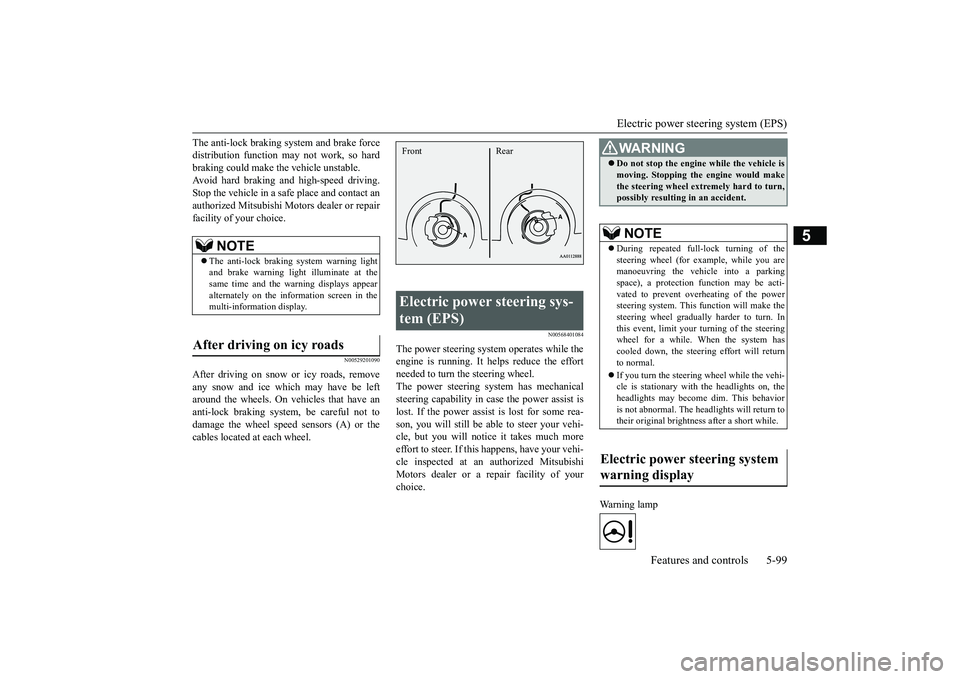
Electric power steering system (EPS)
Features and controls 5-99
5
The anti-lock braking system and brake forcedistribution function ma
y not work, so hard
braking could make the vehicle unstable.Avoid hard braking and high-speed driving.Stop the vehicle in a safe place and contact anauthorized Mitsubishi Mo
tors dealer or repair
facility of your choice.
N00529201090
After driving on snow or icy roads, removeany snow and ice which may have be leftaround the wheels. On vehicles that have ananti-lock braking syst
em, be careful not to
damage the wheel spee
d sensors (A) or the
cables located at each wheel.
N00568401084
The power steering system operates while theengine is running. It helps reduce the effortneeded to turn the steering wheel.The power steering sy
stem has mechanical
steering capability in case the power assist islost. If the power assist is lost for some rea-son, you will still be able to steer your vehi-cle, but you will notice it takes much moreeffort to steer. If this happens, have your vehi-cle inspected at an authorized MitsubishiMotors dealer or a repair facility of yourchoice.
Warning lamp
NOTE
The anti-lock braking
system warning light
and brake warning light illuminate at thesame time and the wa
rning displays appear
alternately on the information screen in themulti-information display.
After driving on icy roads
Electric power steering sys-tem (EPS) Front Rear
WA R N I N GDo not stop the engine while the vehicle ismoving. Stopping the engine would makethe steering wheel extremely hard to turn,possibly resulting
in an accident.
NOTE
During repeated full-lock turning of thesteering wheel (for example, while you aremanoeuvring the vehicle into a parkingspace), a protection f
unction may be acti-
vated to prevent overheating of the powersteering system. This f
unction will make the
steering wheel graduall
y harder to turn. In
this event, limit your turning of the steeringwheel for a while. When the system hascooled down, the steering effort will returnto normal.If you turn the steering wheel while the vehi-cle is stationary with the headlights on, theheadlights may become
dim. This behavior
is not abnormal. The he
adlights will return to
their original brightness after a short while.
Electric power steering system warning display
BK0249100US.book 99 ページ 2017年5月10日 水曜日 午前8時49分
Page 193 of 441
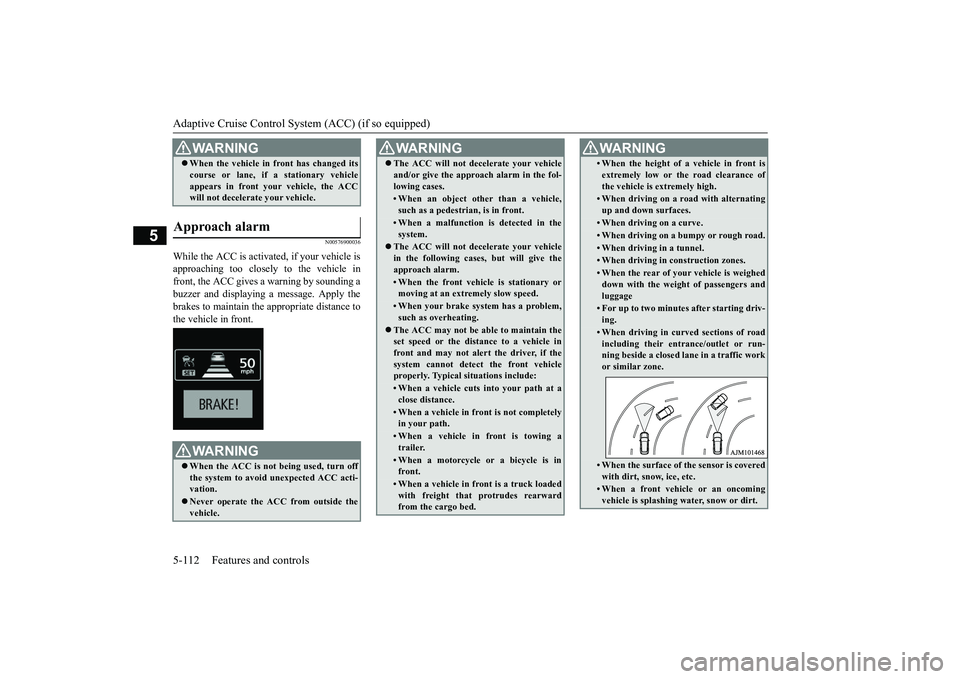
Adaptive Cruise Control System (ACC) (if so equipped)5-112 Features and controls
5
N00576900036
While the ACC is activated, if your vehicle isapproaching too closely to the vehicle infront, the ACC gives a warning by sounding abuzzer and displaying a message. Apply thebrakes to maintain the appropriate distance tothe vehicle in front.When the vehicle in
front has changed its
course or lane, if a stationary vehicleappears in front you
r vehicle, the ACC
will not decelerate your vehicle.
Approach alarm
WA R N I N GWhen the ACC is not being used, turn offthe system to avoid
unexpected ACC acti-
vation.Never operate the AC
C from outside the
vehicle.WA R N I N G
The ACC will not decelerate your vehicleand/or give the approach alarm in the fol-lowing cases.• When an object other than a vehicle,such as a pedestri
an, is in front.
• When a malfunction is detected in thesystem.
The ACC will not decelerate your vehiclein the following cases, but will give theapproach alarm.• When the front vehicle is stationary ormoving at an extr
emely slow speed.
• When your brake system has a problem,such as overheating.
The ACC may not be able to maintain theset speed or the dist
ance to a vehicle in
front and may not alert the driver, if thesystem cannot detect the front vehicleproperly. Typical situations include: • When a vehicle cuts
into your path at a
close distance.• When a vehicle in front is not completelyin your path.• When a vehicle in front is towing atrailer.• When a motorcycle or a bicycle is infront.• When a vehicle in fr
ont is a truck loaded
with freight that protrudes rearwardfrom the cargo bed.WA R N I N G
• When the height of a vehicle in front isextremely low or the road clearance ofthe vehicle is extremely high.• When driving on a r
oad with alternating
up and down surfaces.• When driving on a curve.• When driving on a bumpy or rough road.• When driving in a tunnel.• When driving in construction zones.• When the rear of your vehicle is weigheddown with the weight of passengers andluggage• For up to two minutes after starting driv-ing.• When driving in curved sections of roadincluding their entrance/outlet or run-ning beside a closed lane in a traffic workor similar zone.• When the surface of th
e sensor is covered
with dirt, snow, ice, etc.• When a front vehicle or an oncomingvehicle is splashing wa
ter, snow or dirt.
WA R N I N G
BK0249100US.book 112 ページ 2017年5月10日 水曜日 午前8時49分